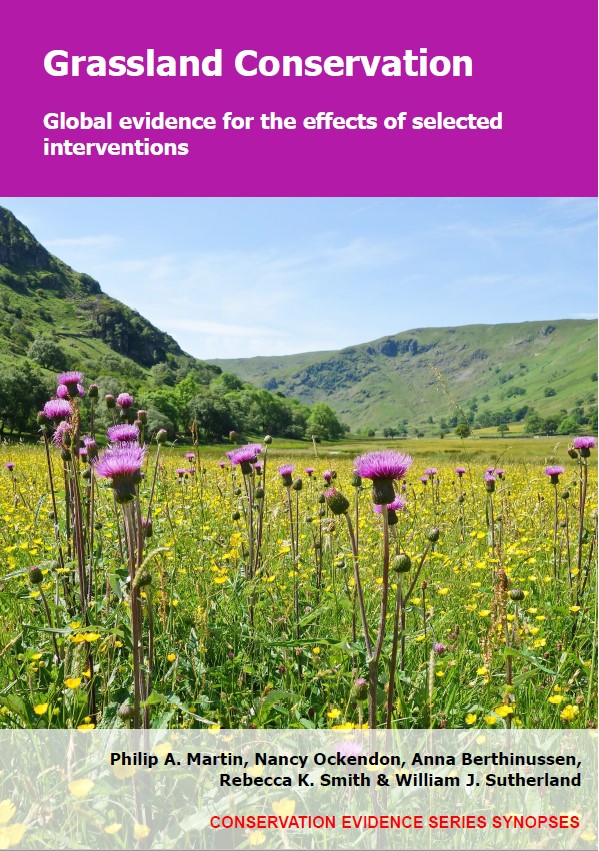Transfer plant material from intact grassland alongside seeding/planting
-
Overall effectiveness category Evidence not assessed
-
Number of studies: 4
View assessment score
Hide assessment score
How is the evidence assessed?
-
Effectiveness
not assessed -
Certainty
not assessed -
Harms
not assessed
Study locations
Supporting evidence from individual studies
A replicated, randomized, controlled study in 2008–2011 in three former arable fields in east Hungary (Török et al. 2012) found that transferring hay alongside sowing seeds led to an increase in the number and cover of target plant species and a decrease in weed species compared to sowing seeds without hay. During three years after sowing seeds, plots with hay added had a greater number and cover of target plant species than plots with no hay added (data reported as statistical model results). The opposite was true for weed species. In October 2008, three fields were prepared (by disking and smoothing) and sown with seeds of Festuca pseudovina at a rate of 20 kg/ha. Following sowing, two 15 x 15 m plots were randomly selected within each field. Hay (from a species-poor native grassland) was spread over one plot/field to a thickness of 5 cm, while the other plot had no hay added. All plots were mown annually. Vegetation was monitored once/year in eight 1-m2 quadrats randomly placed within each plot in 2009–2011.
Study and other actions testedA replicated, randomized, paired, controlled study in 2006–2008 in a mesic grassland in Germany (Schmiede et al. 2013) found that transferring plant material alongside sowing seeds had mixed effects on seedling emergence compared to sowing seeds without plant material. When low amounts of plant material were added (400–800 g/m2), seedling emergence did not differ significantly between plots where plant material was added and seeds were sown (5–8%) and areas where no plant material was added but seeds were sown (7%). However, at high rates of plant material addition (1,600–3,200 g/m2), emergence was lower in plots where plant material was added and seeds were sown (0–1%) than in areas where no plant material was added but seeds were sown (7%). In February 2007, five blocks each containing five 3 × 3 m plots were ploughed and levelled with a harrow. Plant material from an intact grassland was added at a rate of 400, 800, 1,600, or 3,200 g/m2 to one plot in each block, while one plot received no plant material. Seeds of eight species were sown at a rate of 1,600 seeds/plot. Seedling emergence was assessed in each plot in July and October 2007 and April, July and October 2008.
Study and other actions testedA replicated, paired, controlled study in 2009–2015 in a species-poor grassland near Wittenberg, Germany (Baasch et al. 2016) found that transferring hay alongside sowing seeds did not alter the species richness or cover of target grasses and forbs compared to sowing seeds without hay. During six years after sowing seeds, plots with hay added had on average a similar number and cover of target grass and forb species (13–19 species, 12–26%) to plots that had no hay added (14–19 species, 12–20%). In 2009, two 30 x 6 m plots in each of six blocks were rotovated (10 cm depth) and rolled. In each block, green hay and a regional seed mixture were added to one plot. Seeds (obtained from threshing and a regional seed mixture) were sown in the other plot but no hay was added. Hay was obtained from a meadow 3 km away. All plots were mulched twice and mown once in 2009, and mown twice/year in 2010–2015. Vegetation was recorded annually within a 4 x 4 m quadrat in each of the 12 plots in 2010–2015.
Study and other actions testedA replicated, randomized, paired, controlled study in 2009–2014 in a species-poor grassland near Wittenberg, Germany (Engst et al. 2016) found that transferring hay alongside sowing seeds did not alter the richness or cover of target grass and forb species compared to sowing seeds without hay. After five years, there was no significant difference in the average number and cover of target forb and grass species between plots with hay added and seeds sown (forbs: 8 species, 6.7%; grasses: 1.3 species, 2.4%) and plots without hay added and seeds sown (forbs: 6.5 species, 3.2%; grasses: 1.2 species, 2.7%). In 2009, six blocks, each with two plots measuring 30 × 6 m, were established. In each block, hay and a regional seed mixture was added to one tilled and rolled plot. In the other plot, seeds (obtained from threshing and a regional seed mixture) were sown but no hay was added. In 2010–2014, the study site was repeatedly flooded and mown twice a year. Hay was obtained from two nearby sites, which were also regularly flooded and mown. Vegetation in each plot was recorded annually from 2010 to 2014 using 4 x 4 m quadrats.
Study and other actions tested
Where has this evidence come from?
List of journals searched by synopsis
All the journals searched for all synopses
This Action forms part of the Action Synopsis:
Grassland Conservation
Grassland Conservation - Published 2021
Grassland Synopsis





)_2023.JPG)














